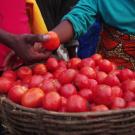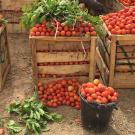This research study focuses on the potential for evaporative cooling devices to address challenges of postharvest storage for fruits and vegetables in Rwanda and Burkina Faso. The study was conducted as part of the Horticulture Innovation Lab research projects focused on reducing postharvest losses in Rwanda and improving postharvest practices for tomatoes in Burkina Faso. The report is written by Eric Verploegen of the Massachusetts Institute of Technology (MIT) D-Lab, with Rashmi Ekka and Gurbinder Gil of Agribusiness Associates.
The study tested the zero-energy cool chamber (ZECC) and a clay pot cooler, collecting data via sensors for temperature and relative humidity changes, fruit and vegetable shelf life observations, and user interviews.
Summary and highlights: Evaporative cooling report
The horticulture sector plays a vital role in supporting human nutrition and income generation for farmers in Rwanda and Burkina Faso. A lack of affordable and effective postharvest fruit and vegetable storage solutions often leads to spoilage, loss of income, reduced access to nutritious foods, and significant amounts of time spent traveling to sell and purchase fresh produce (fruits and vegetables), particularly in rural communities. Studies conducted in Rwanda and Burkina Faso indicate that postharvest losses for perishable products like tomatoes are between 50–60 percent.
The objective of this research study is to investigate the potential for non-electric evaporative cooling devices to address challenges of postharvest fruit and vegetable storage in Rwanda and Burkina Faso. The two classes of devices evaluated in this study are commonly known as “Zero Energy Cooling Chambers” (ZECCs), which are generally used by horticulture farmers, farmer groups and cooperatives, and “clay pot coolers,” which are generally used in households (and sometimes called "zeer pots"). These devices rely on the evaporation of water to create a cooling effect, and their performance is significantly affected by the ambient temperature and humidity of the environment in which they operate.
In this study, we used a combination of electronic sensors, fruit and vegetable shelf life measurements, and structured user interviews to gather information about users’ needs for improved postharvest storage, current methods of postharvest storage, and the performance of the evaporative cooling devices.

How evaporative cooling works
The ZECC and clay pot cooler devices in this study function on the principle of direct evaporative cooling, where heat is removed as water evaporates from the surface of the storage device. The evaporative cooling effect causes a decrease in temperature and an increase in the relative humidity inside the storage device, conditions that increase the shelf life of many fruits and vegetables. Water must be added at regular intervals to maintain the cooling effect. The watering frequency required can vary from several times a day to only a few times a week, depending on the storage device’s material and design as well as the weather conditions. However, the rate of evaporation of water is highly dependent on the ambient humidity. When the ambient humidity is higher, there is a less significant reduction of the interior temperature.
Most techniques for cooling and storing fruits and vegetables rely on electricity — which is unavailable or unaffordable in most rural areas in Rwanda and Burkina Faso — limiting access to effective and affordable postharvest storage options. The evaporative cooling devices that are the subject of this study function without the use of electricity and so are well suited for regions without electricity access, or where electricity dependent cooling and storage technologies are not affordable. Effective, affordable cooling and storage technologies have the potential to prevent food loss, increase access to fresh produce, and create opportunities for additional income generation in off-grid areas and where electricity is intermittent or prohibitively expensive.

Results from evaporative cooling devices
The results of this research indicate that evaporative cooling devices can provide value across a range of environmental conditions and fruit and vegetable types, and uncovered the following insights in Rwanda and Burkina Faso.
The devices provide increased humidity, decreased daily average temperatures, decreased peak daily temperatures, and improved temperature stability, all of which can lead to improved vegetable shelf life. All of the devices provide a minimum of the following benefits:
- An average interior humidity greater than 95 percent.
- A decrease in the average daily temperature between 1 and 3 degrees Celsius (ºC).
- A reduction in daily temperature fluctuations from 10–20 ºC each day to less than 4 ºC throughout a given day. It is important to note that even when there is not a significant decrease in the average temperature, it is beneficial to store produce in an environment with a stable temperature.
- The peak daily temperature is reduced by 7–15 ºC, and avoidance of peak temperatures above 30 ºC.
In Burkina Faso the clay-pot-in-clay-pot cooler design provided a larger decrease (8 ºC) in the average temperature than designs with a clay pot in a dish or a plastic container in a clay pot (4–5 ºC).
Farmers using brick ZECCs in Rwanda reported shelf life improvements ranging from 2 to 4 times for specific vegetables compared to the shelf life in ambient conditions.
Fruit and vegetable vendors are suffering significant financial losses due to spoilage and can benefit from evaporative cooling devices.
Barriers and constraints to evaporative cooling technology adoption
- The high humidity in Rwanda (during the research period) limits the temperature decrease that can be achieved.
- Fungal contamination from the sides of inner clay surfaces or spreading of rot from one fruit and vegetable type to another can accelerate deterioration. Plastic or metal inner containers may be used to avoid this issue.
- Cost of construction of ZECC and acquisition of crates is a barrier for many potential users studied.
- As the ZECC is a temporary structure, there is risk of the ZECC falling apart especially because of heavy rain.
- Organizing the construction, use, and security of shared ZECCs requires planning and coordination.
Recommendations for scaling up use of evaporative cooling, including ZECCs and clay pot coolers
The following recommendations were generated based on the results of this research study:
- Connect potential users with existing users of evaporative cooling devices to share advice on construction, and use, and cost of these devices.
- In addition to households and farmers, specifically, target the dissemination of evaporative cooling devices (ZECCs and clay pot coolers) to fruit and vegetable vendors and markets with permanent structures who suffer financial losses due to spoilage.
Additional recommendations for construction, use, and dissemination of evaporative cooling devices can also be found in the Evaporative Cooling Best Practices Guide.
Appendix of the evaporative cooling report
An additional appendix document includes additional figures and tables, including the number and locations of the evaporative cooling devices, photos of both the clay pots and zero energy cool chambers in use, a diagram of the sensor system used for data collection. The appendix also includes graphs of additional sensor data and graphs of vegetable shelf life in each location of the field trials in Rwanda: Busogo, Rubona and Mulindi.


